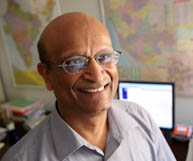Research and Discovery: In India, research helps farms help themselves
Research and Discovery: In India, research helps farms help themselves McGill University
User Tools (skip):
RESEARCH AND DISCOVERY
In India, research helps farms help themselves

Dr G.S. Vijaya Raghavan: sharing lessons around the world.
Owen Egan
In its 60th year of independence, India is becoming an economic contender on the global scene. Its cities are booming even though the vast majority of India lives in agricultural settings. One McGill professor who believes ‘you are what you eat' is helping farms deliver the best food to the table to keep India strong.
"Farming is the foundation of life in much of India," says Dr G.S. Vijaya Raghavan, James McGill Professor in Bioresource Engineering at McGill University's Macdonald campus. "After the harvest, inefficiency can be devastating. You could feed one-third of India's poor if you captured losses each year."
Since Dr Raghavan came to McGill in 1974, he has made it his mission to keep post-harvest losses from eating into the profits of farming operations. Efforts such as these have motivated McGill to promote collaboration, most notably the 2006-2007 McGill India Strategic Research Initiative (see Entre Nous with Denis Therien on page 4 for more information).
Raghavan explains that despite a large volume of food production in India, losses of 10 to 30 percent for grains and 22 to 40 percent for fruits and vegetables subtract from what goes to market, costing farms US$15 billion annually. The costs of running a farm have risen during the last century, and so have the costs paid externally for crop processing. The majority of Indian farms are small land holdings and their ability to make a profit is shrinking fastest of all.
Fortunately, successful intervention feeds on itself. "Once you show farmers and entrepreneurs the ‘best practices,' they want to learn more and more," says Raghavan.
Dr Raghavan has been steering a project with $5 million in funding from the Canadian International Development Agency (CIDA) for five years. Under his leadership, the benefits of applied agricultural engineering begin to sustain themselves.
How does this happen? Says Raghavan, "Value addition can greatly enhance post-harvesting operations and food markets for very little initial investment."
‘Value addition' occurs when, for example, farmers sort tomatoes into groups. Not all tomatoes are created equal, and if they all flood the market, price crashes result in unsold, rotten tomatoes. Top-quality tomatoes fetch the highest prices, and low-quality tomatoes are sold for less elsewhere. Lesser-quality tomatoes can be saved for canning if the farm sets up the proper facility, and the lowest-quality tomatoes yield antioxidant compounds if extraction equipment is available.
The CIDA project has the capacity to bring to fruition similar innovations because it is comprehensive. "People get their own land, buildings and electricity connections. We provide training, machinery and the link with universities for research," Raghavan explains. Profits are reinvested, providing more jobs and literally ‘growing the farm.'
On the farm, staff learn farm management and applications for technology. They become more market-savvy and they set up machinery for threshing, pasteurizing, canning and other operations. "By installing a threshing machine to clean grain, the quality goes up immediately, and the machine pays for itself," says Raghavan.
Most often there is no heavy equipment, and women form ‘self-help groups,' organized collectives that add value to the crops by carrying out hands-on tasks. A win-win-win for employment, food security and women's empowerment, strategies for women to work on the farm are a top priority for both the Indian government and the CIDA project.
Off the farm, graduate students at State Agricultural Universities (TNAU, UAS-Dharwad, UAS-Bangalore) and McGill test their ideas in laboratories. Research includes everything from drying cranberries in large microwave ovens for long-term storage to cleaning nutritious millet grain so it can compete with rice. Raghavan's project has funded more than 40 Macdonald graduate students, and worked with more than 100 students at Indian institutions. He has also hired undergraduates from the IITs (Indian Institute of Technology, at various cities) as interns, whom he encourages to stay on for advanced degrees.
"Attracting graduate students who are dedicated to this cause is quite easy. Macdonald campus and agricultural institutions in India have a lot to gain through partnerships," says Raghavan.
As the CIDA project is in its final year, a stakeholder meeting was held in August to gauge success. "Everyone involved was enthusiastic about the results. We are already drafting new proposals," says Raghavan. To date, more than 5,000 beneficiaries in different South Indian villages have received training. More than 10 percent have started entrepreneurial ventures and have increased their average incomes by 8 to 15 percent.
"We can share these lessons with agricultural societies around the world—and the world's food security in rural areas is in desperate need," says Raghavan. "If people do not address post-harvest issues, even abundant food production may yield only scarce food supplies."

